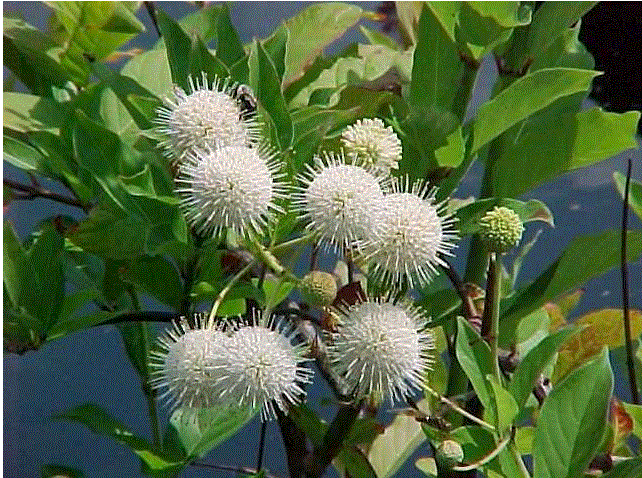St Charles County Master Gardeners
Click on address for map.
636-875-7457
Menu
Buttonbush
Cephalanthus occidentalis
Family:
Rubiaceae (madders)
Description:
A large multistemmed shrub or small tree, growing in low areas, often swollen at the base.
Leaves opposite but more commonly in whorls of 3, blades 2-8 inches long, oval or lance-shaped, tip pointed, margin lacking teeth; dark green, smooth above, paler with a few hairs along veins beneath. Leaf stalk smooth and stout.
Bark thin, gray to brown, later with flattened ridges and deep grooves.
Twigs dark reddish-brown to gray-brown, shiny, smooth.
Flowers June-September, in fragrant, ball-shaped clusters 1-1½ inches wide, on stalks 1-3 inches long; individual flowers minute, 4-petaled, white, with protruding styles. The floral clusters arise from upper leaf axils and at stem tips.
Fruits September-October, a round cluster of reddish-brown, dry, pyramidal nutlets. Pods remain for some time before splitting open.
Size:
Height: to 18 feet.
Habitat and conservation:
Occurs in borders of lakes, rivers, sloughs, swamps, sinkhole ponds, river bottoms and low, wet woods. Always found near water; often found in thickets, which can be impenetrable.
Distribution in Missouri:
Statewide.
Human connections:
Buttonbush is frequently planted as an ornamental. Its thickets can be planted to protect lakeshores from erosion. Native Americans had several medicinal uses for this plant, using it as an emetic, laxative, tonic and pain reliever. White settlers used buttonbush medicinally, too.
Ecosystem connections:
The nutlets are eaten by many types of birds, especially water birds, including wood ducks, and pheasants. The fragrant flowers are a favorite nectar source for honeybees. Song sparrows, red-winged blackbirds and other birds nest in this shrub. Animals may be poisoned by eating the leaves.

